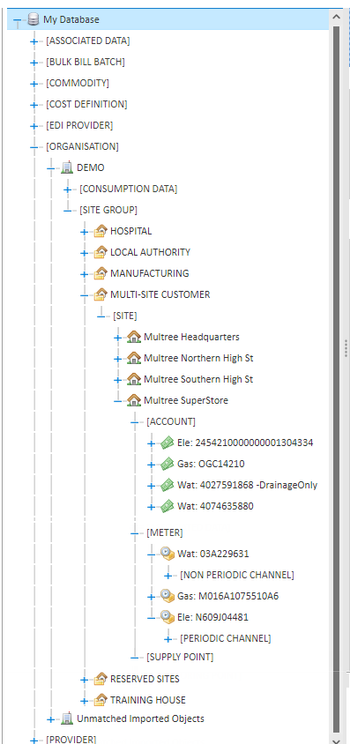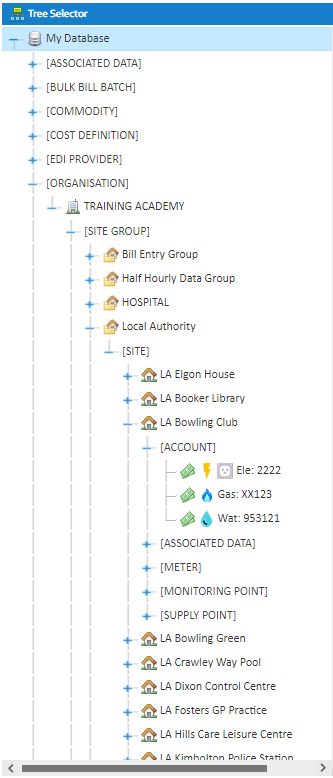Introduction
...
The following table provides an overview of the different item types shown in Fig.2.
Item Type | Level | Purpose |
|---|---|---|
Provider | 1 | A Provider is the legal entity that supplies you with services or a utility for which you expect to be charged. A single Provider may supply you with more than one utility (e.g. Electricity and Gas). Within Sigma there are three main types of Provider which are; Supplier, Meter Operator or Data Collector and Aggregator. A single Provider may fulfil any one or more of these services. |
Contract | 2 | A Contract is a referenceable agreement between you and the Provider. A Contract may be evergreen in which case the Permanent option is selected, or it may be timebound, having both a start date and an end date. |
Organisation | 1 | The Organisation is the top-level entity with respect to the portfolio's physical structure. An Organisation may be created for each legal entity that is billed and responsible for the consumption of utilities, or a single Organisation may be created for an entire group. In most cases a single Organisation is used to manage a customer's portfolio. |
Site Group | 2 | Site Groups are another level of hierarchical configuration in addition to Organisations. Site Groups are completely optional and may or may not be used. Site Groups can be used to structure your portfolio in a logical way. Site Groups might for example be used to mirror the geographic distribution (e.g. North, East, etc…), the cost centre that the Sites attributed to them belong to (e.g. Retail, Manufacturing, etc..) or some other frequently referenced grouping with your organisation. As Property Keys can be used to assign specific properties, the selection of the Site Group is not the only way in which Sites can be distinguished as you could for example configure with graphical site groups and then assign a cost centre based property and use that to select and work on Sites. |
Site | 3 | Sites are the physical locations to which your utilities are supplied. These will typically be buildings and be referenceable by a postcode. Sites have specific properties and the contact details of someone that is responsible for them. Over time a Site may be Closed or become Non-Operational. The specification of Sites is typically easier than the selection of the number and level of Organisations and Site Groups to create as they are a one to one mapping with the physical distribution of your infrastructure. |
Account | 4 | Accounts in Sigma are the items that represent the granular Supply Point level at which you are billed. It is anticipated that there be only one Supply Point effective for an Account on any one specific day. An Account is also expected to be for a single commodity, so while it may be that a Supply Point is associated to an Account, and its configuration may change over time resulting in multiple Supply Point records, it is not expected that Supply Points for different commodities are associated to the same Account. |
Supply Point | 4 | Supply Points represent the industries' physical infrastructure required for the provision of a utility of a given commodity to your Site. In the case of utilities that aren't supplied continuously (e.g. Oil Deliveries), the Supply Point represents the storage facility on-site. |
Meter | 4 | A Meter is the equipment that measures and records the flow of a utility through a Supply Point during a period of time. The provision of utilities is often measured based on recording the amount consumed directly or recording readings of how much has flowed through the Meter at two separate times and then inferring that the amount consumed is the difference between the readings. |
Non Periodic Channel | 5 | Channels are the time series data holders that are used in Sigma to record and manage data. Similar to Meters, and their use of readings or consumption, Channels come in two types; Non-Periodic and Periodic. |
Periodic Channel | 5 | A Periodic Channel is used to record data for cases where the measurement of consumption is performed on a routine recurring periodic basis. |
Associated Data | 6 | Associated Data is used to record supplementary information to be used in validation or the calculation of data. Examples of the use of Associated Data include the definition of floor areas for sites to enable the calculation of usage per m2 rates, the definition of the Agreed Supply Capacities for Supplies to be used in the validation of charges or the definition of PPU rates for Accounts which are also used in the validation of charges. |
Contract Container | 6 | Contract Containers are the intermediary object used to relate Contracts, Accounts, Supply Points and Meters. A Contract Container defines, for a period of time, the Contract that is applicable for the provision of a utility through the Meters on a Supply Point that is billed via an Account. |
Property Key | 6 | Property Keys are the method by which it is possible to assign custom data to the entities in your Utility Portfolio. These custom properties can then be used to search for records in your portfolio. |
Table 1: Sigma Item Types List
...
Attached is the template to be used for the definition of your portfolio.
| View file | ||||
|---|---|---|---|---|
|
Note: Click then click on to download the CSV file.
Summary
The content of Sigma can be displayed via the Sigma application using the Tree Selector. When this is used a hierarchy, similar to a typical folder and file structure, is displayed.
Fig 2: Example Sigma Tree Selector
In the above figure there are more item types than have been described in Table 1 as this example has been taken from a Sigma Environment that has been used, and therefore contains the additional items that are created during the use of Sigma. For the initial configuration of a Sigma environment only the items defined in Table 1 need to be created.
The spreadsheet in Section 3.2 is used to create the items in Table 1 in a new Sigma environment.
Each field in the spreadsheet is colour coded to identify whether the data is mandatory in Sigma or if it is recommended that the data is provided to get the full benefit of the Sigma features:
Colour | Data Required in Sigma |
| Mandatory Fields |
| Highly Recommended |
Recommended Fields, non-essential | |
| Non Essential |
...
Each tab in the workbook is a template representing a set of data to be loaded into Sigma. The tabs allow for the definition of information that will be used to create one, two or three items in Sigma. The Organisation & Site Groups and Sites tabs are mandatory and must be populated as a minimum for data to be loaded into Sigma. The other tabs can be populated largely depending on the intended use of Sigma.
Tab | Number of Item Types | Items | Intended Sigma Usage |
|---|---|---|---|
Organisation | 1 | Organisations | Energy Management & Bill Validation (hence always Mandatory) |
Site Groups and Sites | 2 | Site Groups | Energy Management & Bill Validation (hence always Mandatory) |
Account and Supply | 2 | Accounts | Bill Validation |
Meter and Channel | 2 | Meters | Energy Management requires both Meter and Channel information & Bill Validation only requires Meter information |
Provider and Contract | 3 | Providers | Bill Validation |
Property Keys | 1 | Property Keys | Optional for Bill Validation (use effectively means additional validation is possible) |
Associated Data | 1 | Associated Data | Optional for Bill Validation (use effectively means additional validation is possible) |
Table 2: Item Definition Requirements based on Intended Usage
...
Specific tabs include fields that are only mandatory if the tab is being used to create child items. The cases where this is applicable are defined in the table below.
Tab | Mandatory Condition | Rationale |
|---|---|---|
Meter and Channel | Mandatory if Channel is being added | The Meter and Channel worksheet caters for the creation of Meters and associated Channels. If Channels are being defined then the fields listed as "Mandatory if Channel is being added" are required. |
Provider and Contract | Mandatory if Contract is being added | The Provider and Contract tab can be used to define the Contracts that supplies are under. If this capability is to be used the fields listed as "Mandatory if Contract is being added" are required. |
Provider and Contract | Mandatory if Contract Container is being added | The Provider and Contract tab can be used to define the Contract Containers that link the Accounts, Supplies and Meters to the Contracts that they are provisioned/serviced under. If this capability is to be used the fields listed as "Mandatory if Contract Container is being added" are required. |
Table 3: Mandatory Condition Clarification
...


